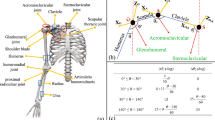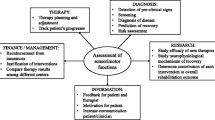Abstract
Bio-signal based assessment for upper-limb functions is an attractive technology for rehabilitation. In this work, an upper-limb function evaluator is developed based on biological signals, which could be used for selecting different robotic training protocols. Interaction force (IF) and participation level (PL, processed surface electromyography (sEMG) signals) are used as the key bio-signal inputs for the evaluator. Accordingly, a robot-based standardized performance testing (SPT) is developed to measure these key bio-signal data. Moreover, fuzzy logic is used to regulate biological signals, and a rules-based selector is then developed to select different training protocols. To the authors’ knowledge, studies focused on biological signal-based evaluator for selecting robotic training protocols, especially for robot-based bilateral rehabilitation, has not yet been reported in literature. The implementation of SPT and fuzzy logic to measure and process key bio-signal data with a rehabilitation robot system is the first of its kind. Five healthy participants were then recruited to test the performance of the SPT, fuzzy logic and evaluator in three different conditions (tasks). The results show: (1) the developed SPT has an ability to measure precise bio-signal data from participants; (2) the utilized fuzzy logic has an ability to process the measured data with the accuracy of 86.7% and 100% for the IF and PL respectively; and (3) the proposed evaluator has an ability to distinguish the intensity of biological signals and thus to select different robotic training protocols. The results from the proposed evaluator, and biological signals measured from healthy people could also be used to standardize the criteria to assess the results of stroke patients later.






Similar content being viewed by others
References
Sheng B, Zhang Y, Meng W, Deng C, Xie S (2016) Bilateral robots for upper-limb stroke rehabilitation: state of the art and future prospects. Med Eng Phys 38(7):587–606
Maciejasz P, Eschweiler J, Gerlach-Hahn K, Jansen-Troy A, Leonhardt S (2014) A survey on robotic devices for upper limb rehabilitation. J Neuroeng Rehabil 11(1):3
Fugl-Meyer AR, Jääskö L, Leyman I, Olsson S, Steglind S (1975) The post-stroke hemiplegic patient. 1. a method for evaluation of physical performance. Scand J Rehabil Med 7(1):13–31
Bohannon RW, Smith MB (1987) Interrater reliability of a modified Ashworth scale of muscle spasticity. Phys Ther 67(2):206–207
Bosecker C, Dipietro L, Volpe B, Igo Krebs H (2010) Kinematic robot-based evaluation scales and clinical counterparts to measure upper limb motor performance in patients with chronic stroke. Neurorehabil Neural Repair 24(1):62–69
Van Kan GA, Rolland Y, Andrieu S, Bauer J, Beauchet O, Bonnefoy M, Cesari M, Donini L, Gillette-Guyonnet S, Inzitari M (2009) Gait speed at usual pace as a predictor of adverse outcomes in community-dwelling older people an International Academy on Nutrition and Aging (IANA) Task Force. J Nutr Health Aging 13(10):881–889
Otten P, Kim J, Son SH (2015) A framework to automate assessment of upper-limb motor function impairment: a feasibility study. Sensors 15(8):20097–20114
Balasubramanian S, Colombo R, Sterpi I, Sanguineti V, Burdet E (2012) Robotic assessment of upper limb motor function after stroke. Am J Phys Med Rehabil 91(11):S255–S269
de los Reyes-Guzmán A, Dimbwadyo-Terrer I, Trincado-Alonso F, Monasterio-Huelin F, Torricelli D, Gil-Agudo A (2014) Quantitative assessment based on kinematic measures of functional impairments during upper extremity movements: a review. Clin Biomech 29(7):719–727
Nordin N, Xie SQ, Wünsche B (2014) Assessment of movement quality in robot-assisted upper limb rehabilitation after stroke: a review. J Neuroeng Rehabil 11(1):137
Krebs HI, Hogan N, Aisen ML, Volpe BT (1998) Robot-aided neurorehabilitation. IEEE Trans Rehabil Eng 6(1):75–87
Park H-S, Kim J, Damiano DL (2012) Development of a haptic elbow spasticity simulator (HESS) for improving accuracy and reliability of clinical assessment of spasticity. IEEE Trans Neural Syst Rehabil Eng 20(3):361–370
Ma Y, Xie S, Zhang Y (2016) A patient-specific EMG-driven neuromuscular model for the potential use of human-inspired gait rehabilitation robots. Comput Biol Med 70:88–98
Hermens HJ, Freriks B, Merletti R, Stegeman D, Blok J, Rau G, Disselhorst-Klug C, Hägg G (1999) European recommendations for surface electromyography. Roessingh Res Dev 8(2):13–54
De Luca CJ (1997) The use of surface electromyography in biomechanics. J Appl Biomech 13(2):135–163
Rechy-Ramirez EJ, Hu H (2015) Bio-signal based control in assistive robots: a survey. Digital Commun Netw 1(2):85–101
Cavanagh PR, Komi PV (1979) Electromechanical delay in human skeletal muscle under concentric and eccentric contractions. Eur J Appl Physiol Occup Physiol 42(3):159–163
Shao Q, Bassett DN, Manal K, Buchanan TS (2009) An EMG-driven model to estimate muscle forces and joint moments in stroke patients. Comput Biol Med 39(12):1083–1088
Au AT, Kirsch RF (2000) EMG-based prediction of shoulder and elbow kinematics in able-bodied and spinal cord injured individuals. IEEE Trans Rehabil Eng 8(4):471–480
James CJ, Jones RD, Bones PJ, Carroll GJ (1999) Detection of epileptiform discharges in the EEG by a hybrid system comprising mimetic, self-organized artificial neural network, and fuzzy logic stages. Clin Neurophysiol 110(12):2049–2063
Si Y, Gotman J, Pasupathy A, Flanagan D, Rosenblatt B, Gottesman R (1998) An expert system for EEG monitoring in the pediatric intensive care unit. Electroencephalogr Clin Neurophysiol 106(6):488–500
Zhang Z, Liparulo L, Panella M, Gu X, Fang Q (2015) A fuzzy kernel motion classifier for autonomous stroke rehabilitation. IEEE J Biomed Health Inform 99:1–9
Letham B, Rudin C, McCormick TH, Madigan D (2015) Interpretable classifiers using rules and Bayesian analysis: building a better stroke prediction model. Ann Appl Stat 9(3):1350–1371
Sheng B, Zhang Y, Tang L, Xie S, Deng C (2018) A bilateral training system for upper-limb rehabilitation: a follow-up study. In: 2018 IEEE/ASME international conference on advanced intelligent mechatronics (AIM). IEEE, pp 839–844
Seeder L (1983) Muscle strength grading. Ann Emerg Med 12(6):407
Islam F, Shoilee SBA, Shams M, Rahman RM (2017) Potential risk factor analysis and risk prediction system for stroke using fuzzy logic. In: Computer science on-line conference. Springer, New York, pp 262–272
Lilly JH (2011) Fuzzy control and identification. Wiley, Hoboken
Musikasuwan S, Garibaldi J (2006) Exploring Gaussian and triangular primary membership functions in non-stationary fuzzy sets. In: Proceedings of information processing and management of uncertainty in knowledge based systems
Zhao J, Bose BK (2002) Evaluation of membership functions for fuzzy logic controlled induction motor drive. In: IECON 02 IEEE 2002 28th annual conference of the Industrial Electronics Society. IEEE, pp 229–234
Mamdani EH, Assilian S (1975) An experiment in linguistic synthesis with a fuzzy logic controller. Int J Man Mach Stud 7(1):1–13
Brunnstrom S (1956) Associated reactions of the upper extremity in adult patients with hemiplegia: an approach to training. Phys Ther 36(4):225–236
Chatterjee S (2015) Brunnstrom concept. SlideShare. https://www.slideshare.net/Drsubhasishchatterje/brunnstrom
Saebo (2015) The Brunnstrom stages of stroke recovery. Saebo movement. https://www.saebo.com/the-stages-of-stroke-recovery/
Kronberg M, NÉmeth G, Broström L (1990) Muscle activity and coordination in the normal shoulder. An electromyographic study. Clin Orthop Relat Res 257:76–85
Jobe FW, Tibone JE, Perry J, Moynes D (1983) An EMG analysis of the shoulder in throwing and pitching: a preliminary report. Am J Sports Med 11(1):3–5
Moseley JRJB, Jobe FW, Pink M, Perry J, Tibone J (1992) EMG analysis of the scapular muscles during a shoulder rehabilitation program. Am J Sports Med 20(2):128–134
Hu X, Tong K, Song R, Zheng X, Lui K, Leung W, Ng S, Au-Yeung S (2009) Quantitative evaluation of motor functional recovery process in chronic stroke patients during robot-assisted wrist training. J Electromyogr Kinesiol 19(4):639–650
Sharma N, Classen J, Cohen LG (2013) Neural plasticity and its contribution to functional recovery. Handbook of clinical neurology, vol 110. Elsevier, Amsterdam, pp 3–12
Carmichael ST (2016) Phases of stroke recovery: cellular and molecular mechanisms. American society of neurorehabilitation. https://www.asnr.com/files/2016%20Annual%20Meeting/Carmichel%20Phases%20of%20Stroke%20Recovery%20ASNR.pdf
Volpe B, Krebs H, Hogan N, Edelstein L, Diels C, Aisen M (2000) A novel approach to stroke rehabilitation robot-aided sensorimotor stimulation. Neurology 54(10):1938–1944
Pau JW, Xie SS, Pullan AJ (2012) Neuromuscular interfacing: establishing an EMG-driven model for the human elbow joint. IEEE Trans Biomed Eng 59(9):2586–2593
Clarkson HM (2000) Musculoskeletal assessment: joint range of motion and manual muscle strength. Lippincott Williams & Wilkins, Philadelphia
Hu X, Tong K, Tsang VS, Song R (2006) Joint-angle–dependent neuromuscular dysfunctions at the wrist in persons after stroke. Arch Phys Med Rehabil 87(5):671–679
Sheng B, Tang L, Xie S, Deng C, Zhang Y (2019) Alterations in muscle activation patterns during robot-assisted bilateral training: a pilot study. Proc Inst Mech Eng H 233(2):219–231
Chan AD, Englehart KB (2004) Continuous myoelectric control for powered prostheses using hidden Markov models. IEEE Trans Biomed Eng 52(1):121–124
Ajiboye AB, Weir RF (2005) A heuristic fuzzy logic approach to EMG pattern recognition for multifunctional prosthesis control. IEEE Trans Neural Syst Rehabil Eng 13(3):280–291
Huang H-P, Chen C-Y (1999) Development of a myoelectric discrimination system for a multi-degree prosthetic hand. In: Proceedings 1999 IEEE International Conference on Robotics and Automation (Cat. No. 99CH36288C). IEEE, pp 2392–2397
Subasi A, Gursoy MI (2010) EEG signal classification using PCA, ICA, LDA and support vector machines. Expert Syst Appl 37(12):8659–8666
Bu N, Okamoto M, Tsuji T (2009) A hybrid motion classification approach for EMG-based human–robot interfaces using Bayesian and neural networks. IEEE T Robot 25(3):502–511
Sabeti M, Boostani R, Katebi S, Price G (2007) Selection of relevant features for EEG signal classification of schizophrenic patients. Biomed Signal Process Control 2(2):122–134
Yom-Tov E, Inbar GF (2002) Feature selection for the classification of movements from single movement-related potentials. IEEE Trans Neural Syst Rehabil Eng 10(3):170–177
Wei L, Hu H (2010) EMG and visual based HMI for hands-free control of an intelligent wheelchair. In: 2010 8th world congress on intelligent control and automation. IEEE, pp 1027–1032
Dzierzanowski JM, Bourne JR, Shiavi R, Sandell HS, Guy D (1985) GAITSPERT: an expert system for the evaluation of abnormal human locomotion arising from stroke. IEEE Trans Biomed Eng 11:935–942
Xu X, Zhang L, Wang Z (2015) Stroke risk prediction system based on fuzzy comprehensive evaluation method. Comput Simul 32(7):344–347
Acknowledgements
Research supported by the Faculty Research Development Fund of the University of Auckland under Grant No. 3717395, the International S&T Cooperation Program of China (ISTCP) under Grant No. 2016YFE0121700, the Science and Technology Development Fund of Macao S.A.R (FDCT) under MoST-FDCT joint Grant No. 015/2015/AMJ, and China Sponsorship Council under Grant No. 201508250001.
Author information
Authors and Affiliations
Corresponding author
Ethics declarations
Conflict of interest
The authors declare that they have no conflicts of interest.
Ethical approval
The ethical approval has been approved by the University of Auckland Human Participants Ethics Committee (reference 015256).
Informed consent
Informed consent was obtained from all participants.
Additional information
Publisher's Note
Springer Nature remains neutral with regard to jurisdictional claims in published maps and institutional affiliations.
Electronic supplementary material
Below is the link to the electronic supplementary material.
Rights and permissions
About this article
Cite this article
Sheng, B., Tang, L., Moosman, O.M. et al. Development of a biological signal-based evaluator for robot-assisted upper-limb rehabilitation: a pilot study. Australas Phys Eng Sci Med 42, 789–801 (2019). https://doi.org/10.1007/s13246-019-00783-0
Received:
Revised:
Accepted:
Published:
Issue Date:
DOI: https://doi.org/10.1007/s13246-019-00783-0




